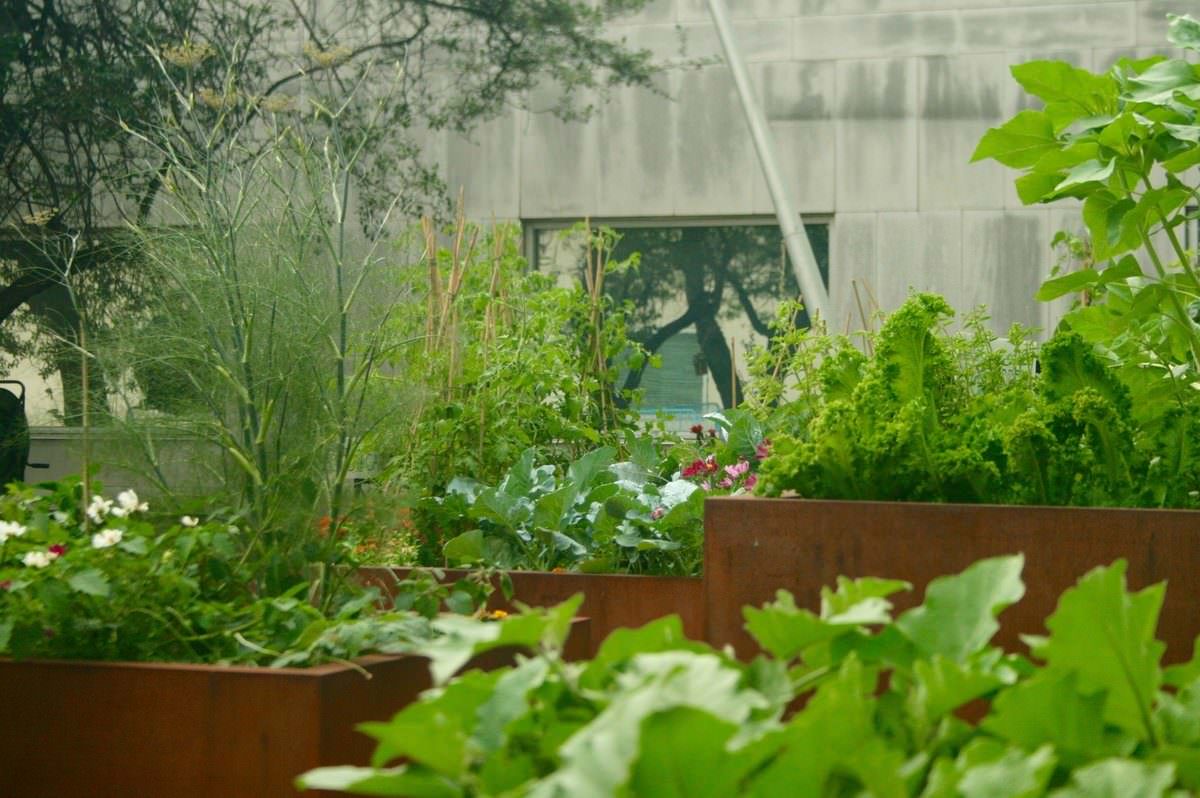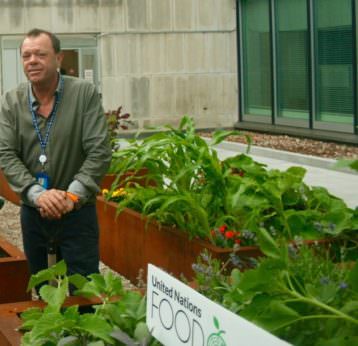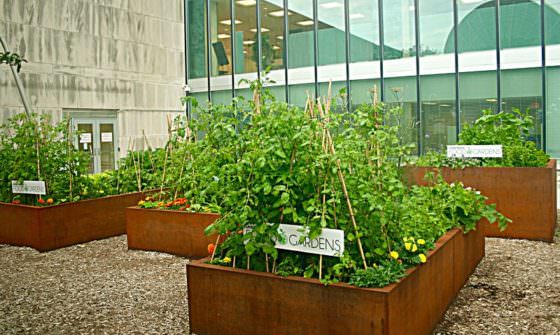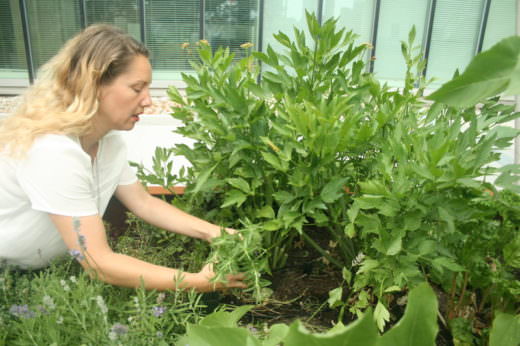Take a Tour of the UN’s Small-Scale and Diverse Food Gardens
A group of volunteer UN employees grows a global selection of fruits and vegetables in the middle of New York City.
Take a Tour of the UN’s Small-Scale and Diverse Food Gardens
A group of volunteer UN employees grows a global selection of fruits and vegetables in the middle of New York City.

The idea for gardens at the United Nations was hatched in late 2014 by a (now former) UN employee, Arif Khan, as he walked around the grounds and saw what he considered “wasted space.” He dreamed up the idea as a place where a team of employees, now called the UN Garden Club, could volunteer to work and put some of the ideas advocated by the UN – environmental responsibility, food security, small-scale agriculture, for example – into practice.
“I thought it would be a great symbolic garden where people would come together and share ideas around growing food,” Khan tells me during a recent phone conversation. “It’s meant to showcase urban gardening, but also to bring people together over something that is basic to being human.”
I recently toured the food gardens – which opened in July of last year and are in their second growing season – with Catherine Zanev, who took over after Khan left the UN late last summer. Zanev is an associate expert for climate change in the UN’s Chief Executives Board for Coordination, and along with the others in the five-to-10 member UN Garden Club team, volunteers her time. I followed her as she weaved her way through the massive UN complex, through the General Assembly and Secretariat buildings, past the hanging portraits of the various UN Secretaries, down a hall that screamed 1960s institutional architecture, and finally through a door requiring an electronic ID to exit.
The atmosphere changes dramatically as you enter the food gardens, which encompass close to 200 feet of growing space. The ten beautifully designed metal raised beds are packed with a wide assortment of vegetables and fruits from around the world (as you’d expect from an organization made up of 193 nations), from Korean chives to Indonesian peppers to Caribbean callaloo, all growing in profusion next to each other.
Plants thrive here. Michael Jenkins, a member of the Garden Club who works in the UN’s medical service, believes that’s partly due to the vast amount of windows of the Secretariat building, which rises 39 stories up in front of the garden and helps concentrate light on the plants. This creates a microclimate that allowed lemongrass, for instance, to live all the way to January of this past year.
The food is all grown organically, and the plants are watered with a micro-drip irrigation system. The gardeners have created a “biodiversity bed” featuring plants that draw beneficial insect species, and have also started a composting program to supply the garden with nutrient-dense humus and keep food scraps from the UN facility out of local landfills. Mason bees arrived this past April and live in the garden’s bee box.

When developing the gardens, the UN Garden Club partnered with the New York City Parks Department and Brooklyn Grange, an organic rooftop farm. William Gates, a friend of Khan’s, who is an architect and retired NYFD firefighter, designed the garden and has continued to be involved in the project. They also received support from Planterworx – a Brooklyn-based landscape product company – Baker Creek Heirloom Seed Company, and Gardener’s Supply Company.
Along with providing food for UN employees, the gardens donate produce to Butter Beans, the company that runs UNICEF’s canteen, and have provided ingredients for appetizers at a UN World Food Day event. The volunteers have partnered with various UN agencies, too: the Food and Agriculture Organization to promote the International Year of Pulses – in some of the beds chickpeas, lentils, and other legumes grow so people can see what the plants look like – and the International Fund for Agricultural Development to showcase some of the agricultural technologies the UN is using around the world.
But beyond that, the gardens have become a place for UN employees and other staff to have a chance to plant a seed, step away from their desk, or bask in a little greenery. “It’s just nice to be able to come out here and take a break from your long day at the computer and get your hands dirty,” says Zanev.


Later this month the UN Food Gardens will host 100 young people involved with the park department’s Greenthumb Community Garden Youth Leadership Council who’ve been spending the summer working in community gardens across the city. In the future, Zanev says they hope to expand to a bigger space in the complex and integrate the garden into the public UN tours.
As Zanev and I walked back towards the exit after the tour, as if on cue, a fellow UN worker stopped her in the hall to sign up to work in the garden. Afterwards, Zanev laughed and told me it wasn’t staged. Interest in the UN Food Gardens is clearly growing.
Follow us
This work is licensed under a Creative Commons Attribution-NoDerivatives 4.0 International License.
Want to republish a Modern Farmer story?
We are happy for Modern Farmer stories to be shared, and encourage you to republish our articles for your audience. When doing so, we ask that you follow these guidelines:
Please credit us and our writers
For the author byline, please use “Author Name, Modern Farmer.” At the top of our stories, if on the web, please include this text and link: “This story was originally published by Modern Farmer.”
Please make sure to include a link back to either our home page or the article URL.
At the bottom of the story, please include the following text:
“Modern Farmer is a nonprofit initiative dedicated to raising awareness and catalyzing action at the intersection of food, agriculture, and society. Read more at <link>Modern Farmer</link>.”
Use our widget
We’d like to be able to track our stories, so we ask that if you republish our content, you do so using our widget (located on the left hand side of the article). The HTML code has a built-in tracker that tells us the data and domain where the story was published, as well as view counts.
Check the image requirements
It’s your responsibility to confirm you're licensed to republish images in our articles. Some images, such as those from commercial providers, don't allow their images to be republished without permission or payment. Copyright terms are generally listed in the image caption and attribution. You are welcome to omit our images or substitute with your own. Charts and interactive graphics follow the same rules.
Don’t change too much. Or, ask us first.
Articles must be republished in their entirety. It’s okay to change references to time (“today” to “yesterday”) or location (“Iowa City, IA” to “here”). But please keep everything else the same.
If you feel strongly that a more material edit needs to be made, get in touch with us at [email protected]. We’re happy to discuss it with the original author, but we must have prior approval for changes before publication.
Special cases
Extracts. You may run the first few lines or paragraphs of the article and then say: “Read the full article at Modern Farmer” with a link back to the original article.
Quotes. You may quote authors provided you include a link back to the article URL.
Translations. These require writer approval. To inquire about translation of a Modern Farmer article, contact us at [email protected]
Signed consent / copyright release forms. These are not required, provided you are following these guidelines.
Print. Articles can be republished in print under these same rules, with the exception that you do not need to include the links.
Tag us
When sharing the story on social media, please tag us using the following: - Twitter (@ModFarm) - Facebook (@ModernFarmerMedia) - Instagram (@modfarm)
Use our content respectfully
Modern Farmer is a nonprofit and as such we share our content for free and in good faith in order to reach new audiences. Respectfully,
No selling ads against our stories. It’s okay to put our stories on pages with ads.
Don’t republish our material wholesale, or automatically; you need to select stories to be republished individually.
You have no rights to sell, license, syndicate, or otherwise represent yourself as the authorized owner of our material to any third parties. This means that you cannot actively publish or submit our work for syndication to third party platforms or apps like Apple News or Google News. We understand that publishers cannot fully control when certain third parties automatically summarize or crawl content from publishers’ own sites.
Keep in touch
We want to hear from you if you love Modern Farmer content, have a collaboration idea, or anything else to share. As a nonprofit outlet, we work in service of our community and are always open to comments, feedback, and ideas. Contact us at [email protected].by Andrew Amelinckx, Modern Farmer
July 20, 2016
Modern Farmer Weekly
Solutions Hub
Innovations, ideas and inspiration. Actionable solutions for a resilient food system.
ExploreExplore other topics
Share With Us
We want to hear from Modern Farmer readers who have thoughtful commentary, actionable solutions, or helpful ideas to share.
SubmitNecessary cookies are absolutely essential for the website to function properly. This category only includes cookies that ensures basic functionalities and security features of the website. These cookies do not store any personal information.
Any cookies that may not be particularly necessary for the website to function and are used specifically to collect user personal data via analytics, ads, other embedded contents are termed as non-necessary cookies.